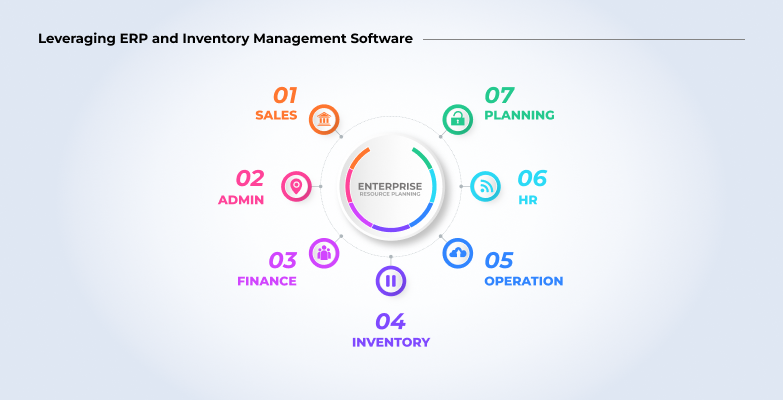Hey! Lets Talk about your project
We’ll contact you within a couple of hours to schedule a meeting to discuss your goals.
Common Inventory Tracking Mistakes and How to Avoid Them
Posted on : 23 July, 2025
Maintaining accurate stock records is critical for any business.
Inaccurate tracking can be extremely costly: one report estimates that global losses from inventory miscounts (overstock and stockouts) reached about $1.77 trillion in 2023. Discrepancies between recorded and actual inventory lead directly to stockouts (missed sales), excess inventory, and higher holding costs. These gaps “can lead to stockouts, overstocking, lost sales, and increased carrying costs”. Common causes include human entry errors, out-of-date systems, and disconnected processes. Fortunately, most of these pitfalls are avoidable with better processes and technology.
Manual Processes and Data-Entry Errors
One pervasive mistake is relying on manual data entry, spreadsheets or paper logs. Humans are error-prone: for instance, Gartner found that 41% of businesses still log inventory manually. MoldStud research estimates that about 70% of inventory discrepancies stem from human error.
- Use barcode or RFID scanning. Automate counts by scanning items as they are received or sold. This removes manual typing mistakes. For example, Sortly notes that mobile barcode scanning eliminates “jumbling numbers” inherent in spreadsheets.
- Implement real-time inventory software. Adopt an integrated inventory management or ERP system that updates stock levels instantly. This means each sale or purchase immediately reflects in inventory, eliminating the need for separate manual record-keeping.
- Standardize data entry procedures. Train staff on consistent naming, units and counting methods. Ensure everyone follows the same protocols so errors don’t slip through inconsistent formats. Regularly audit data entries and have a second person verify counts.
By eliminating paper and spreadsheets, and moving to a centralized digital system, companies dramatically reduce manual errors. In short, replace one-off spreadsheets with inventory management software to automate and audit every stock transaction.
Lack of Real-Time Visibility and Integration
Another common mistake is failing to maintain real-time, connected inventory data. If stock levels aren’t updated immediately, records go stale. For example, imagine a product sold in-store and online at the same time: without a synced system, both channels might think the item is in stock and both accept orders. The result is an angry customer or last-minute scramble. Key solutions include:
- Use cloud-based inventory tools. Opt for inventory software that provides live updates on stock levels. Cloud or multi-location systems keep data in sync across warehouses and sales channels. This way, every location sees the true on-hand quantity at all times.
- Integrate all systems. Connect your inventory module with point-of-sale, e-commerce, purchasing, and accounting systems. In a unified ERP, every sale or stock move automatically updates the inventory count. This eliminates mismatches between sales orders and inventory records.
- Automate stock adjustments. Set up workflows so that receiving goods, processing returns, and sales all automatically adjust stock. Modern ERP platforms support these automated postings, so there’s no room for a team member to “forget” to subtract sold units.
By ensuring the inventory system is live and integrated, businesses avoid the classic oversell/undersell errors. Every stock move is captured in real time, preserving accuracy.
Poor Forecasting and Planning

Mistakes in demand forecasting and reorder planning directly cause stockouts or dead stock. Relying on intuition rather than data leads to both overstocking and understocking. To fix this:
- Leverage historical data and analytics. Use sales history and market trends to predict future needs. Invest in forecasting tools (many ERP systems have them) that apply statistical models or AI to your data.
- Implement safety stock and reorder points. Calculate a buffer level for each SKU based on variability. Tyasuite’s recommendations include “establishing safety stock levels to cushion against unexpected demand spikes”. This ensures that sudden surges or supplier delays don’t immediately cause a stockout.
- Review and adjust regularly. No forecast is perfect; regularly compare projections to actual sales. Companies should review key metrics (like inventory turnover rates) and tweak forecasts.
In practice, data-driven planning means you order based on demand patterns, not gut feel. Accurate demand forecasting software built into your ERP can even suggest optimal order quantities, keeping stock levels balanced.
Overstocking and Stockouts
Closely related to forecasting, simply having the wrong quantities is a mistake. Overstocking ties up cash, risks obsolescence, and raises storage costs, while understocking (stockouts) causes missed sales and unhappy customers.
- Monitor inventory turnover. Keep a close eye on how fast products sell. Fast-movers may need more frequent reordering, while slow-movers should have minimal stock or be discontinued. Analyzing turnover helps adjust orders so you don’t over-purchase low-demand items.
- Use Just-In-Time (JIT) ordering. For some products, ordering small quantities more frequently is effective. This reduces carrying costs. Modern systems can automate this by triggering orders when inventory falls below a threshold.
- Set automated alerts. Many inventory platforms offer low-stock warnings. Configure your system to notify you when a SKU dips near its reorder point. This way, you never let replenishable stock run dry without notice.
Through these measures, overstocking and stockouts become rare. In effect, the system continuously tunes orders to meet demand without tying up extra capital.
Warehouse Organization and Process Flaws
A physical warehouse that’s in disarray leads to tracking errors. If products are piled haphazardly, employees will inevitably lose or miscount items. Sortly warns that a “disorderly warehouse layout” makes it hard to find goods and often causes unnecessary over-ordering of items already in stock. Key remedies include:
- Apply ABC analysis. Classify inventory by importance (e.g. 20% of items that generate 80% of turnover).
- Leverage warehouse management features. If your ERP has a WMS or if you use dedicated WMS software, take advantage of it. A good WMS will enforce location assignments and record every move (e.g. picking, putaway).
- Keep slow and fast movers separate. Physically separate deadstock or bulky items from daily picks. This avoids mix-ups. If possible, store high-turn products near packing/shipping areas, and put rarely needed items farther back.
By organizing the warehouse logically and using technology (barcodes, RFID, WMS), you cut down on misplacements. A well-organized facility means counts from the floor immediately match what’s expected in the system, reducing “ghost stock” and miscounts.
Lack of Audits and Reconciliation
Disregarding regular inventory audits is a critical oversight. Without cycle counting or periodic full counts, small errors accumulate.
- Schedule frequent cycle counts. Perform partial counts on a rotating schedule (daily, weekly or monthly depending on SKU class).
- Reconcile immediately. When you discover a variance, investigate right away. Determine if it’s a data-entry error, theft, damage, or shrinkage (e.g. spoilage). Don’t let unknown discrepancies linger; adjust counts as needed and trace the root cause.
- Audit the audit process. Occasionally have a supervisor or third party re-count critical items to ensure the process is working. This double-check deters fraud and trains staff to be more accurate.
Lack of audits can also mask shrinkage. Shrinkage (loss of inventory to theft, damage or error) quietly erodes stock levels.
Siloed Systems and Poor Integration
Failing to connect inventory with other business systems is a severe mistake. If your online store isn’t linked to inventory, an ecommerce sale won’t reduce stock automatically, leading to overcommitments. To correct this:
- Integrate ERP/POS with Inventory. Use an ERP or inventory platform that ties together sales channels, procurement, and accounting.
- Automate transaction posting. Ensure that invoices, purchase orders, and receipts all post directly to inventory. Many integrated systems allow you to configure workflows: e.g., an approved supplier invoice automatically adds items to stock.
- Regularly audit integrations. Occasionally check that all systems are correctly synced (e.g. new product entries in POS match those in inventory). This catches mapping errors early.
With full integration, the opportunity for data gaps vanishes. An ERP-centric approach means once-and-only-once data entry: record it at the source, and all relevant modules get updated. As a result, mistakes from double-handling data disappear.
Training, Policies, and Ownership
Sometimes the error is not technical but organizational. Other typical issues include reliance on a single employee (the “inventory guru” who alone knows the counts) or lack of cross-training. To fortify your system:
- Document standard procedures. Write down each step of the inventory process: how to receive shipments, how to inspect goods, how to conduct counts, etc. Ensure procedures cover all inventory actions.
- Train all staff. Invest in thorough training. Everyone should know the proper way to record inventory moves and use the system.
- Avoid single-person dependency. Cross-train multiple people on the inventory routines. This prevents a situation where only one person can perform a key task (e.g. cycle counts) or where knowledge is lost if someone leaves.
- Assign accountability. Make inventory accuracy a clear responsibility. For example, have specific staff members own the process (with KPIs tied to inventory accuracy rates). When people know they are accountable, they tend to be more careful.
By enforcing discipline and making inventory everyone’s job, you cut down errors due to oversight. Consistent training and policies make sure the system you designed is actually followed.
Leveraging ERP and Inventory Management Software

All the above mistakes – manual errors, miscounts, out-of-sync data – point to one solution: a robust inventory management software/ERP. Modern ERP systems are built to eliminate these pain points.
- Centralized data and automation. Every stock movement (sale, purchase, transfer) is recorded digitally in one place. This removes the human re-entry mistakes we discussed.
- Real-time visibility. With cloud ERP, inventory levels update instantly. Managers can check on-hand quantities from any location at any time, enabling quick decision-making. Mobile access (scanning via tablets/phones) means warehouse staff always work off current data.
- End-to-end reporting. Inventory insights become part of broader financial reports. This improves forecasting and reveals profit-impacting trends.
Ready to ditch messy spreadsheets? Try IPIX, the best ERP Software in India, for seamless inventory, billing, and accounting in one smart platform.



































 Talk to our Expert
Talk to our Expert
